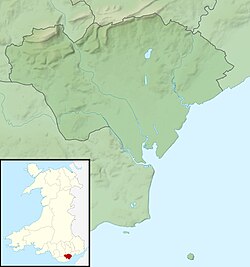Castell-y-mynach
| Castell-y-mynach | |
|---|---|
 The north and west frontages | |
| Type | Manor house |
| Location | Creigiau, Cardiff, Glamorgan |
| Coordinates | 51°31′16″N 3°19′28″W / 51.521°N 3.3244°W |
| Built | 15th century |
| Architectural style(s) | Vernacular |
| Owner | Privately owned |
Listed Building – Grade II* | |
| Official name | Castell-y-mynach |
| Designated | 14 February 1952 |
| Reference no. | 13517 |
Castell-y-mynach (the castle of the monks), is a 15th century manor house in Creigiau, Cardiff, Wales. One of the largest late-medieval houses in Glamorgan, it is a Grade II* listed building.
History
[edit]The house was originally the home of the Mathews family,[1] reputedly built by a Robert Mathews in the 15th century.[2] At the time of construction, it was among the largest late-medieval houses in Glamorgan.[3] A later owner was Thomas Mathew, High Sheriff of Glamorgan in 1614. Known as the "bullying squire",[2] tradition suggests that his death was brought about by a disgruntled tenant who inserted an awl into the cushion of Mathews' favourite chair at Castell-y-mynach, causing his demise.[4] The Mathews family line ended in 1720[2] and the house passed into the possession of the Lords Dynevor.[5] By the mid-19th century, when the site was visited and described by Samuel Lewis in his A Topographical Dictionary of Wales, it had descended to the status of a farmhouse.[6] The name of Castell-y-mynach, suggesting a fortified monastic grange, has been challenged in the 20th century, and it is thought more probable that the name reflected a late-medieval wish to attribute antiquity to the site.[7] The house is now entirely surrounded by a 20th-century housing estate.[8]
Architecture and description
[edit]The house is built of rubble stone, which was originally lime washed.[2] The present building consists of two long, two-storey, ranges to an L-plan. John Newman, in his 1995 Glamorgan volume in the Buildings of Wales series, suggests that these form the two remaining sections of an original courtyard house.[3] The quality of the stonemasonry is high.[3] The interior contains some notable wall paintings,[8][a] which Peter Smith, in his study, Houses of the Welsh Countryside, records as "unusually well-preserved".[9] The staircase wall is decorated with red and black lozenge patterns and grotesques with a date of 1602, while the upper hall has a "still more impressive fragment" depicting two male nudes bearing a cartoon of ships in a storm.[3] Newman considers the murals as "worthy of court art of the period".[3]
Castell-y-mynach is a Grade II* listed building.[2]
Notes
[edit]- ^ The house also contains two hatchments, of the Royal Arms of the Stuarts and those of the Mathews family.[2]
References
[edit]- ^ Morris 1901, p. 11.
- ^ a b c d e f Cadw. "Castell-y-mynach (Grade II*) (13517)". National Historic Assets of Wales. Retrieved 31 March 2025.
- ^ a b c d e Newman 1995, pp. 512–513.
- ^ Morris 1901, p. 13.
- ^ Morris 1901, p. 14.
- ^ Lewis 1849, pp. 318–324.
- ^ "Castell y Mynach, Creigiau". Gatehouse Gazetteer. Retrieved 1 April 2025.
- ^ a b "Castell-y-Mynach (300587)". Coflein. RCAHMW. Retrieved 31 March 2025.
- ^ Smith 1988, Photographs.
Sources
[edit]- Lewis, Samuel (1849). A Topographical Dictionary of Wales. London.
- Morris, W. M. (1901). History of Castell-y-Mynach and surrounding district of Creigiau, near Pentyrch (PDF). Pontypridd: Ford Printers.
- Newman, John (1995). Glamorgan. The Buildings of Wales. London, UK: Penguin Books. ISBN 978-0-140-71056-4.
- Smith, Peter (1988). Houses of the Welsh Countryside. London: Her Majesty's Stationery Office. ISBN 978-0-113-00012-8.

